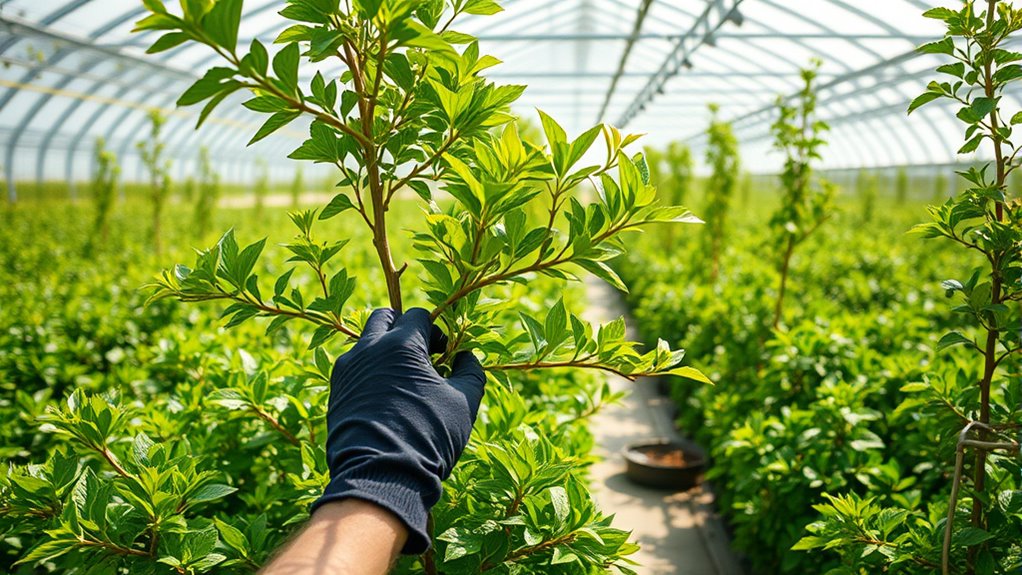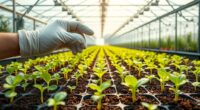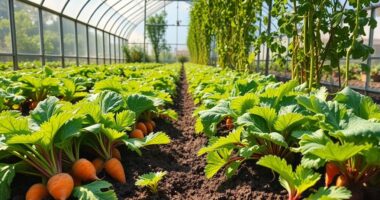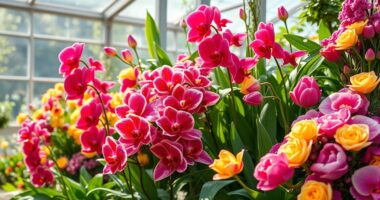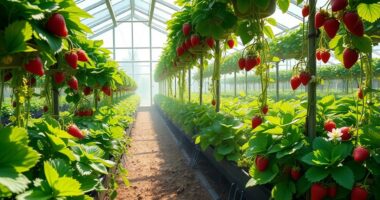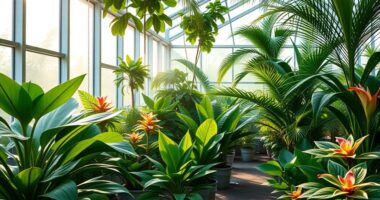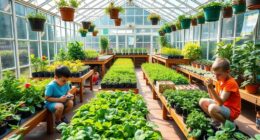Pruning and training your greenhouse plants are key to boosting health, light exposure, and yields. Use sharp, sterilized tools to remove dead or diseased branches, thin crowded areas, and shape your plants with trellises or support frames. Prune regularly, every 4-6 weeks, and monitor growth to adapt your techniques. Avoid over-pruning or harming plants. Continue exploring these strategies to guarantee your greenhouse thrives and maximizes productivity.
Key Takeaways
- Use sharp, sterilized tools for clean cuts and prevent disease transfer during pruning.
- Schedule regular pruning every 4-6 weeks to maintain airflow, shape, and plant health.
- Support training methods like trellising and staking to guide growth and maximize space.
- Remove dead, diseased, or overcrowded branches to improve air circulation and reduce pest risks.
- Monitor plant response by observing new growth and adjust pruning techniques accordingly.
Understanding the Importance of Pruning and Training
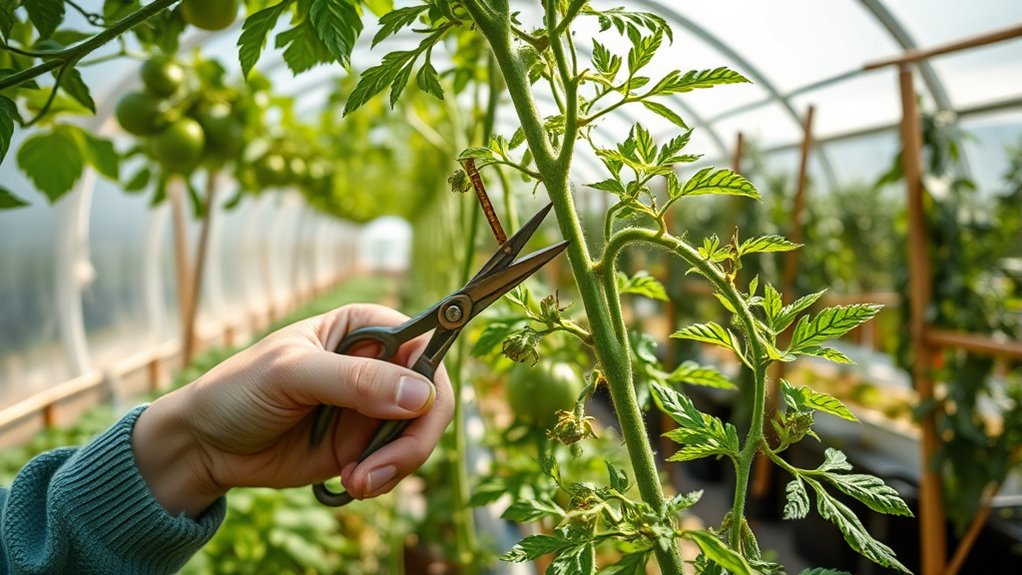
Pruning and training are essential practices that help you maximize plant health and productivity in a greenhouse. By carefully removing dead or diseased leaves, you improve overall plant health, reducing the risk of pests and diseases. Proper pruning also promotes better air circulation, which is vital for pest control, as it limits the environments where pests thrive. Training your plants guides their growth, ensuring they develop strong structures and better light exposure. This not only boosts yield but also makes it easier to spot and manage pest issues early. When you prune and train regularly, you create a healthier, more resilient environment for your plants. Additionally, understanding the importance of proper nutrient management can support your pruning and training efforts by ensuring plants have the necessary nutrients for vigorous growth. This proactive approach minimizes pest problems and supports vigorous growth, helping your greenhouse thrive. Incorporating sustainable practices such as composting and responsible resource use can further enhance plant health and environmental benefits. Utilizing air quality improvements like proper ventilation and filtration can also reduce pathogen spread and improve overall plant well-being. Maintaining optimal humidity levels is also crucial, as it influences plant health and pest development.
Tools and Materials Needed for Effective Pruning
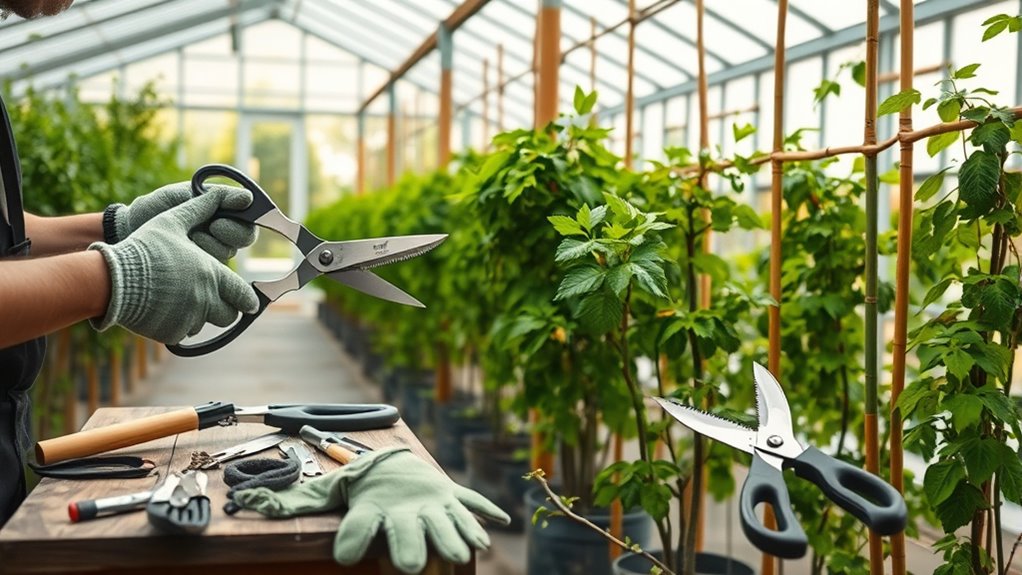
To prune plants effectively, you need the right tools and materials that allow for clean cuts and minimize plant damage. Pruning shears are essential; choose sharp, sterilized ones to ensure smooth cuts and prevent infections. Nissan Tuning techniques emphasize precision and care, which can be applied to plant pruning for better results. A sturdy training trellis helps support plant growth and guides your pruning efforts. Keep a pair of gloves handy to protect your hands from thorns or rough branches. A clean workspace with disinfectant ensures tools stay sanitized between cuts. Additionally, having a pruning saw may be necessary for thicker branches. Proper tools help you make precise cuts, promoting healthy growth and reducing stress on the plants. Investing in quality pruning shears and a durable training trellis makes your pruning process more efficient and effective. Regular maintenance and plant health monitoring are also crucial for sustainable growth, especially considering the importance of indoor air quality in greenhouse environments. Using proper pruning techniques can further enhance plant vitality and prevent common issues like disease spread. Incorporating advanced pruning methods can optimize plant structure and increase yield over time.
Basic Pruning Techniques for Greenhouse Plants
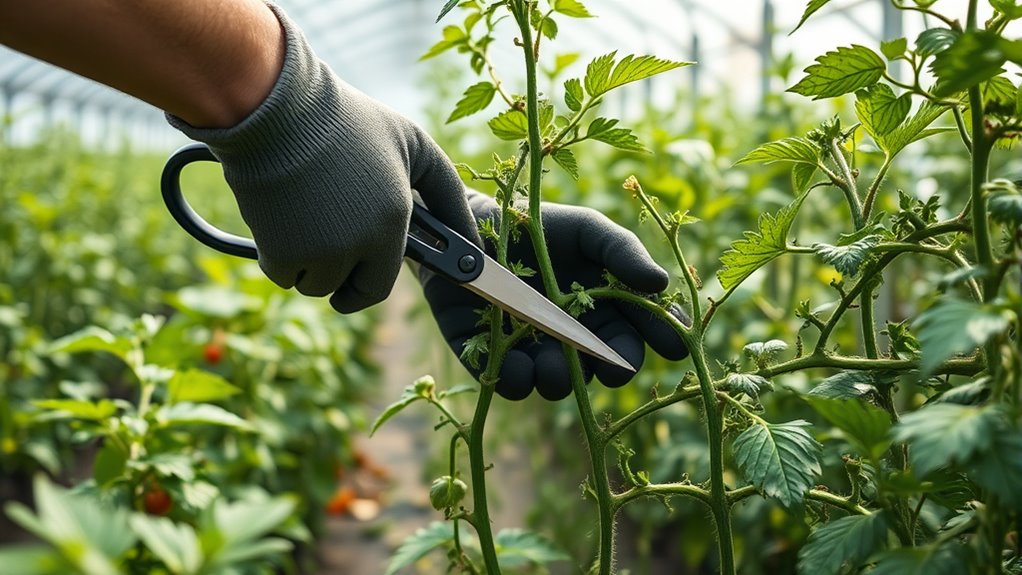
Mastering basic pruning techniques is essential for maintaining healthy and productive greenhouse plants. Proper pruning helps prevent plant disease by improving air circulation and reducing moisture buildup. It also aids pest control, making it harder for pests to hide and thrive. When pruning, focus on removing dead, damaged, or diseased branches, and thin overcrowded areas to promote growth. Use clean, sharp tools to prevent spreading infections. Here’s a quick guide:
| Pruning Step | Purpose | Tips |
|---|---|---|
| Remove dead/diseased | Prevents plant disease spread | Dispose of clippings properly |
| Thin overcrowded | Improves airflow, reduces pests | Avoid over-pruning |
| Cut at the right node | Encourages healthy regrowth | Make clean cuts |
| Remove suckers | Focus plant energy on main growth | Regularly check plants |
| Sanitize tools | Prevents pest and disease transfer | Use alcohol wipes |
Additionally, maintaining proper plant health through regular pruning can enhance overall growth and yield. Incorporating proper timing into your pruning routine ensures that plants recover quickly and remain vigorous. Implementing consistent pruning schedules ensures ongoing plant vigor and productivity. Proper pruning techniques also support the structural integrity of your plants, helping them withstand environmental stresses and encouraging better flowering or fruiting. Regularly monitoring and adjusting your pruning practices based on plant growth stages can lead to more successful cultivation.
Training Methods to Shape and Support Plants
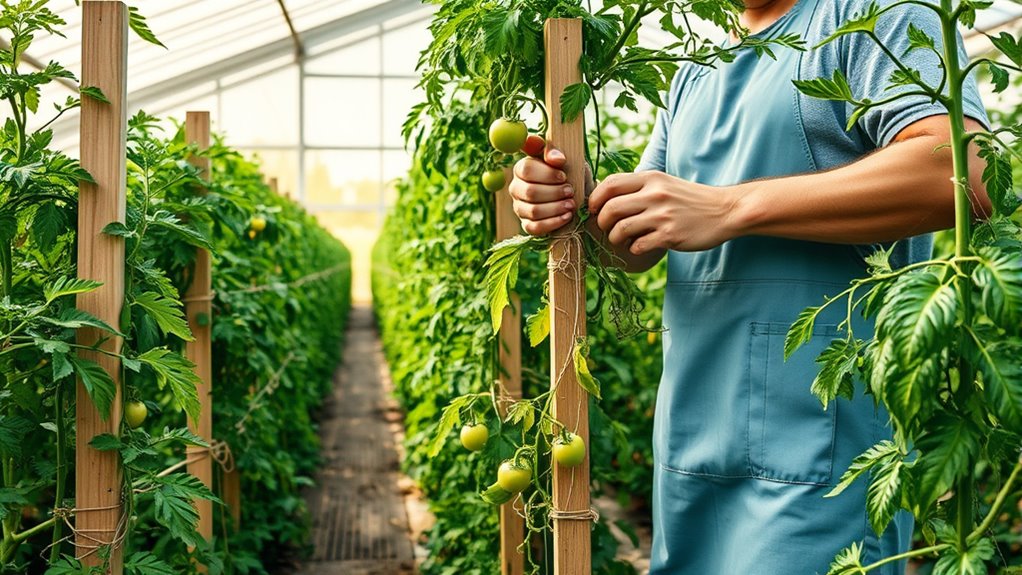
Training methods are essential for shaping and supporting your greenhouse plants to achieve ideal growth and structure. Plant espaliering allows you to grow plants flat against a wall or trellis, maximizing space and airflow while creating attractive displays. To do this effectively, carefully secure branches along a frame, guiding growth in specific directions. Using appropriate support structures enhances plant stability and growth efficiency. Trellis support provides stability for climbing plants, helping them bear weight and stay upright. You can attach stems to trellises using clips or ties, encouraging vertical growth and better light exposure. These training techniques help prevent tangling, promote healthy development, and improve fruit or flower production. By implementing plant espaliering and trellis support, you give your plants a strong foundation, ensuring they grow strong, organized, and visually appealing throughout the season. Proper tire pressure can also influence plant health by reducing vibrations and stress on delicate stems, especially on uneven surfaces. Additionally, understanding plant training techniques can optimize airflow and light penetration, further supporting robust growth. Maintaining optimal watering practices is also crucial, as consistent moisture levels promote healthy development and prevent stress.
Timing and Frequency of Pruning Activities

Timing and frequency are key factors in maintaining healthy, productive greenhouse plants. Properly scheduled pruning aligns with growth cycles, ensuring plants develop strong structure and ideal yields. Understanding plant growth stages helps gardeners determine the best times for pruning and training. Typically, you should:
Properly scheduled pruning aligned with growth cycles ensures healthy, productive greenhouse plants.
- Prune early in the growth cycle to shape plants and remove dead or diseased tissue.
- Repeat pruning every 4-6 weeks during active growth to manage size and airflow.
- Conduct lighter maintenance trims as needed to control pests and prevent infestations. Regular pruning also helps in disease prevention, reducing the likelihood of fungal or bacterial issues spreading within your greenhouse. Consistent pruning supports pest control by reducing hiding spots and improving air circulation. It also encourages vigorous growth, maximizing your plants’ productivity.
Tracking growth stages helps you time activities precisely, avoiding unnecessary stress or damage. Staying attentive to these intervals keeps your greenhouse plants healthy and thriving.
Common Pruning and Training Mistakes to Avoid
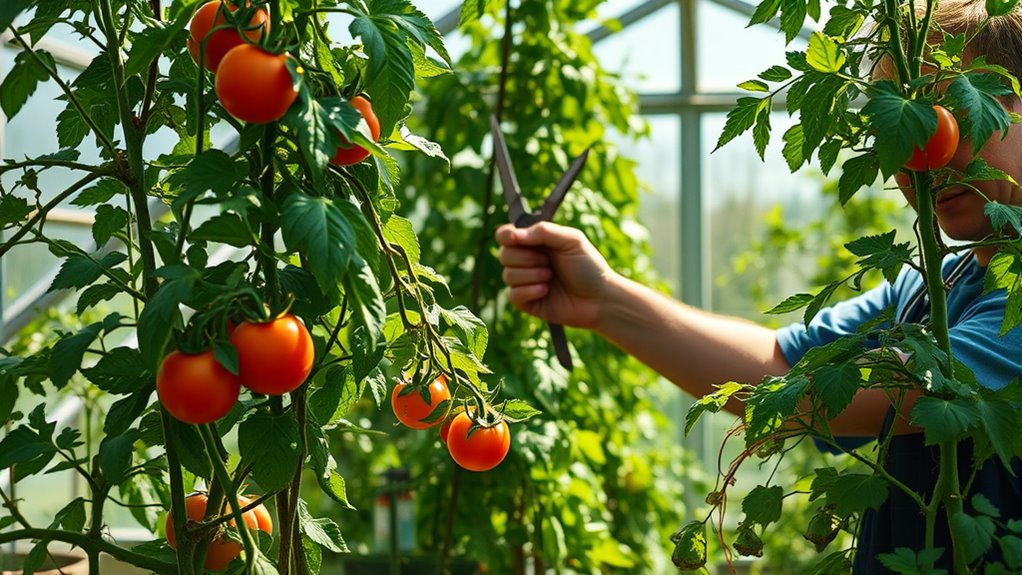
One common mistake in pruning and training plants is removing too much foliage at once, which can shock the plant and stunt its growth. Over pruning weakens the plant’s structure and reduces its ability to photosynthesize effectively. Avoid this by trimming gradually and only removing dead or damaged parts.
Another mistake is ignoring plant signals; if your plant shows signs of stress, such as yellowing leaves or slowed growth, it may need a different approach. Pushing the plant beyond its limits or pruning too aggressively can hinder development.
Always pay attention to how your plants respond and adjust your techniques accordingly. Preventing these mistakes helps promote healthy growth, strong branches, and lush foliage, ensuring your greenhouse plants thrive.
Monitoring Plant Response and Adjusting Techniques
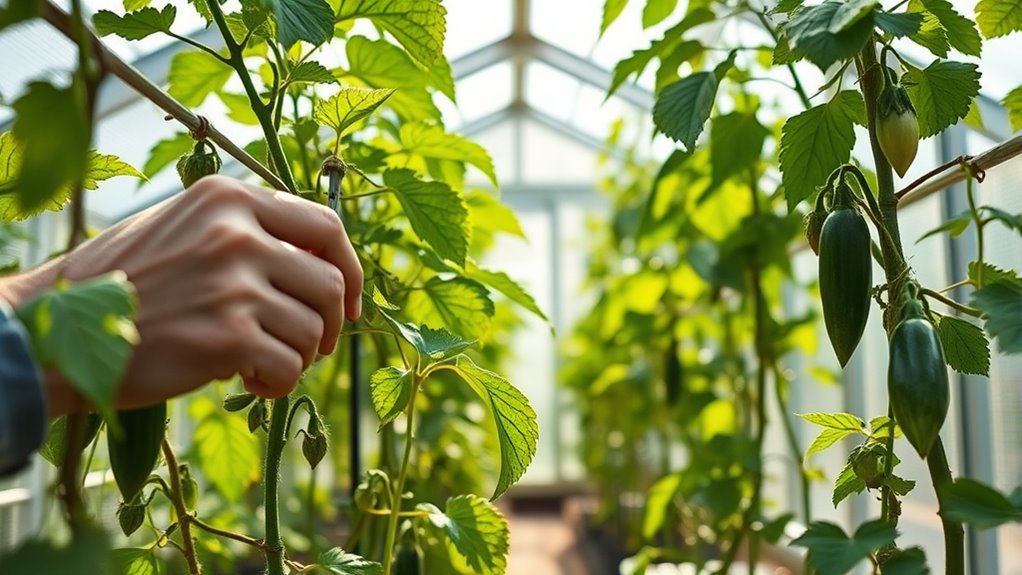
Monitoring how your plants respond after pruning or training is essential to guarantee they stay healthy and grow properly. Pay close attention to growth indicators like new leaf development, stem strength, and overall vigor.
Monitoring plant responses after pruning ensures healthy growth and vitality.
Watch for signs of plant stress, such as wilting, discoloration, or slowed growth, which suggest you need to adjust your techniques.
To effectively monitor, consider these steps:
- Observe changes in leaf color and texture regularly.
- Measure growth rates of new shoots or branches.
- Check for signs of over-pruning or damage affecting plant resilience.
Benefits of Proper Pruning and Training for Greenhouse Success
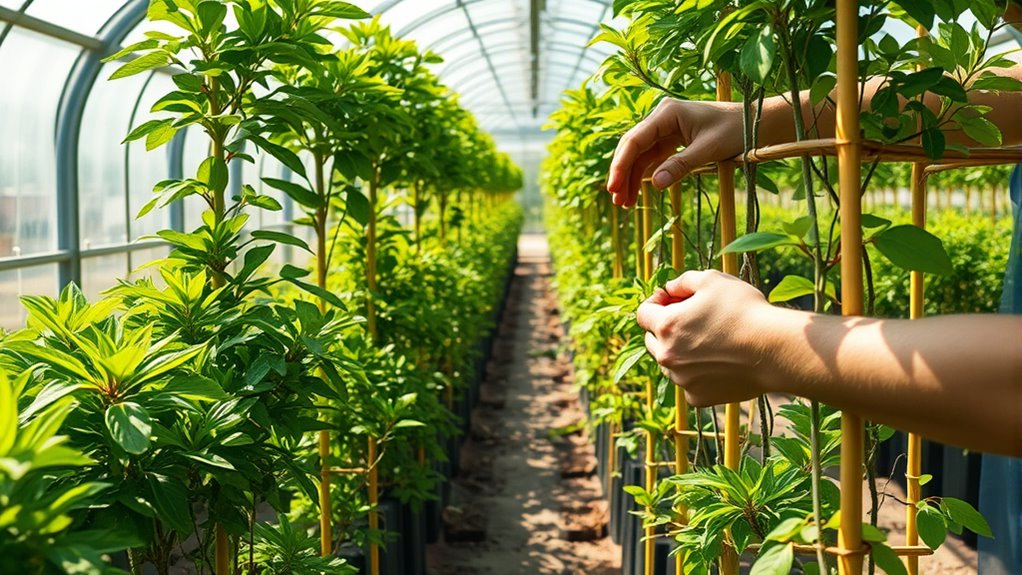
Proper pruning and training are key to maximizing your greenhouse’s productivity and plant health. When you prune correctly, you reduce the risk of plant disease by removing dead or infected tissue, which also improves airflow. Training plants helps control their shape, making pest control easier and more effective. Additionally, well-pruned plants focus energy on fruit or flower production, increasing yield. Proper techniques prevent overcrowding, lowering humidity and discouraging fungal growth. To illustrate, consider this table:
| Benefit | Impact | Result |
|---|---|---|
| Reduces plant disease | Eliminates infected tissue | Healthier plants |
| Improves airflow | Less humidity, fewer pests | Lower pest and disease risk |
| Enhances light penetration | Better growth and fruiting | Increased productivity |
| Controls plant size | Easier maintenance | More efficient space use |
This approach ensures your greenhouse remains healthy and productive.
Frequently Asked Questions
How Do I Identify Which Branches to Prune for Plant Health?
To identify which branches to prune for plant health, focus on branch selection by removing dead, damaged, or diseased stems first.
Look for branches that cross or crowd others, as they can hinder airflow and growth.
Pruning timing is essential; do it when the plant is actively growing or during dormancy to minimize stress.
Always prune just above a healthy bud or node to promote strong, healthy new growth.
Can Pruning and Training Be Combined With Fertilization Routines?
Did you know that proper pruning timing can boost plant growth by up to 30%? Yes, pruning and training can be effectively combined with fertilization routines through integrated nutrient management.
What Are the Signs of Over-Pruning in Greenhouse Plants?
You’ll notice over-pruning when your greenhouse plants show signs like disease spread and structural damage. If you see yellowing, wilting, or stunted growth, it’s a red flag that you’ve removed too much foliage or stems.
Over-pruning weakens plants, making them vulnerable to pests and diseases. To prevent this, prune carefully, avoid excessive cuts, and monitor your plants closely for any signs of stress or damage.
How Does Humidity Affect Pruning and Training Techniques?
Humidity levels critically impact pruning and training techniques. When humidity is too high, your plants may become more prone to diseases, making pruning less efficient as you risk spreading pathogens.
Conversely, low humidity can cause stress, making plants less receptive to training. Maintaining ideal humidity levels helps improve pruning efficiency by reducing stress and disease risk, allowing your plants to recover quickly and respond better to your training efforts.
Are There Specific Pruning Methods for Different Greenhouse Plant Species?
You should use species-specific pruning methods because different plants have unique growth habits and needs. For example, some species respond well to heading cuts, while others benefit from thinning.
Adjust your training techniques accordingly to promote healthy growth and maximize yield. By understanding each plant’s requirements, you guarantee effective pruning that supports both structure and productivity.
Making these tailored adjustments can make your greenhouse management more efficient and better suited to each species.
Conclusion
By mastering pruning and training, you’ll boost plant health and yields markedly. Did you know that proper pruning can increase fruit production by up to 30%? Regularly monitor your plants and adjust techniques as needed to guarantee ideal growth. With the right tools and timing, you’ll see healthier, more productive greenhouse plants. Remember, consistent care makes all the difference—so stay attentive, apply what you’ve learned, and enjoy the thriving greenhouse environment you create.
